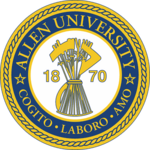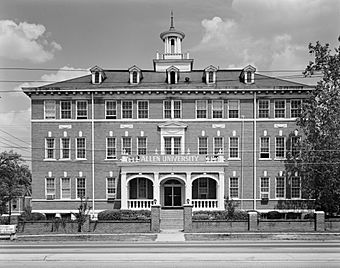Allen University facts for kids
 |
|
|
Former names
|
Payne Institute (1870–1880) |
|---|---|
| Motto | We Teach The Mind To Think, The Hands To Work, The Heart To Love |
| Type | Private historically black university |
| Established | 1870 |
| Affiliation | UNCF |
|
Religious affiliation
|
African Methodist Episcopal Church |
| Endowment | $629,320 (2024) |
| President | Ernest McNealey |
|
Administrative staff
|
530 |
| Students | 677 (fall 2023) |
| Location |
,
,
United States
|
| Campus | Urban |
| Colors | Royal Blue & Gold |
| Nickname | Yellow Jackets |
|
Sporting affiliations
|
NCAA Division II – SIAC |
| Mascot | Yellow Jacket |
 |
|
Allen University is a private university in Columbia, South Carolina, USA. It's known as a historically black university, which means it was founded to provide education for African American students. Today, it has over 600 students. The university campus is so important that it's listed on the National Register of Historic Places.
Contents
A Look Back: Allen University's History
Allen University started in 1870 in Cokesbury, South Carolina. It was first called Payne Institute. Ministers from the African Methodist Episcopal Church, like John M. Brown, created it. Their main goal was to educate formerly enslaved African Americans and their children.
In 1880, the school moved to Columbia. It was renamed Allen University to honor Richard Allen. He was the founder of the African Methodist Episcopal Church. The university is still connected to this church today. Allen University was one of two colleges for Black students in Columbia. It quickly became a very important place in the African American community.
At first, Allen University focused on training ministers and teachers. These roles were seen as key to helping African Americans progress. Over time, the university grew. It began offering many more study areas to its students. In 1885, Joseph W. Morris became the university's president. By 1898, the school had 9 teachers and 304 students.
What Students Can Study
Allen University is approved to offer Bachelor of Arts and Bachelor of Science degrees. These are college degrees you earn after completing your studies. The university organizes its degree programs into five main areas:
- Division of Humanities (like history, literature, and philosophy)
- Division of Social Sciences (like sociology and political science)
- Division of Mathematics and Natural Sciences (like math, biology, and chemistry)
- Division of Business Administration (like business and finance)
- Division of Religion (for those interested in religious studies)
In 2018, Allen University started its first graduate program. It's called the Dickerson-Green Theological Seminary. This seminary offers Master of Arts in Religion and Master of Divinity degrees.
Exploring the Campus
|
Allen University
|
|

Chappelle Administration Building
|
|
| Location | 1530 Harden St., Columbia, South Carolina |
|---|---|
| Built | 1891 |
| NRHP reference No. | 75001705 |
| Added to NRHP | April 14, 1975 |
Many buildings at Allen University are part of the Allen University Historic District. This district was added to the National Register of Historic Places in 1975. Some of these buildings include Arnett Hall, the Chappelle Administration Building, Coppin Hall, the Joseph Simon Flippen Library, and the Canteen Building.
The Allen University Historic District is also part of a special Preservation District in Columbia. This means the city works to protect its historic look. Several buildings on campus have been restored. This was done using money from a special act that helps historic Black colleges and universities.
Chappelle Auditorium: A Place of History
The Chappelle Auditorium is a very important building on campus. It can seat 700 people. This makes it a popular spot for many community events. In 1954, educators and lawyers met here. They started the work that led to the famous US Supreme Court case Brown v. Board of Education. This case helped end segregation in schools.
Many famous people have performed or spoken at the auditorium. These include musicians like Leontyne Price and Brook Benton, and writers like Langston Hughes. Important speakers have included Rev. Martin Luther King Jr., Muhammad Ali, and Rev. Jesse Jackson. The auditorium is named after Bishop William D. Chappelle, who was once president of Allen University. The Chappelle Administration Building itself was recognized as a National Historic Landmark in 1975. It was designed by John Anderson Lankford, a famous Black architect.
Other Campus Buildings
Here are some other buildings on the Allen University campus:
- Adams Gymnatorium
- Arnett Hall
- Cafeteria
- Chappelle Administration Building (a National Historic Landmark)
- Coppin Hall
- Counseling Center
- Dickerson-Green Theological Seminary House
- Flipper Library
- Higgins Hall
- Mance House
- Reid Hall
- Richard Allen Apartments
- Williams Living and Learning Complex
Student Life
Allen University has more than 15 student organizations on campus. These groups help students get involved and make new friends.
Fraternities and Sororities
Allen University is home to eight of the nine national Black fraternities and sororities. These are social organizations that focus on brotherhood, sisterhood, community service, and leadership. They are part of the National Pan-Hellenic Council.
Athletics: The Yellow Jackets
The sports teams at Allen University are called the Yellow Jackets. The university is part of the NCAA Division II. This is a level of college sports competition. The Yellow Jackets mainly compete in the Southern Intercollegiate Athletic Conference (SIAC). They joined this conference again in the 2020–21 school year.
Allen University has 12 different sports teams.
- Men's sports include basketball, cross country, football, track & field, and wrestling.
- Women's sports include basketball, cross country, soccer, softball, track & field, volleyball, and wrestling.
The Band of Gold
After the football program returned in 2018, the university's marching band also came back. It's known as the Band of Gold.
Famous People Who Attended Allen University
Many notable individuals have graduated from Allen University. Here are a few:
- Sam Davis (1967) – A football player who played for the Pittsburgh Steelers.
- Hall Johnson (1908) – An American composer and music arranger.
- Joseph DeLaine (1931) – A minister and civil rights leader. He worked on the Briggs vs. Elliot case, which was part of Brown v. Board of Education.
- Dock J. Jordan (1892) – An American lawyer, author, educator, and civil rights activist.
- Lewis C. Dowdy (1939) – An American educator and former president of North Carolina Agricultural and Technical State University.
- Ralph Anderson (1949) – A former member of the South Carolina House of Representatives and Senate.
- Kay Patterson (1956) – A former member of the South Carolina Senate.
- Clementa Carlos Pinckney (1995) – A former member of the South Carolina House of Representatives and Senate.

